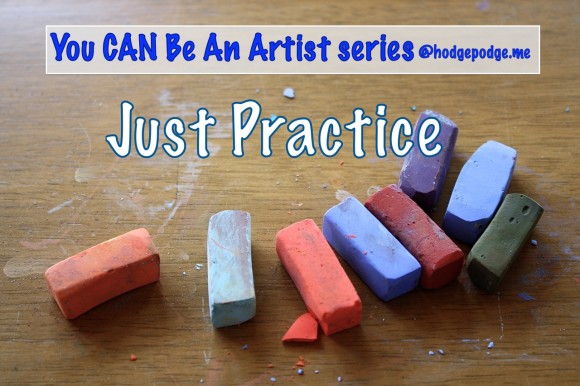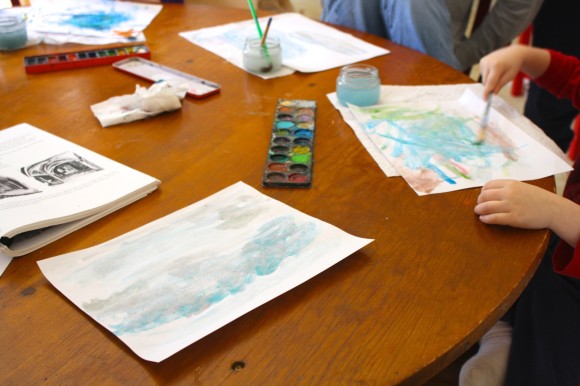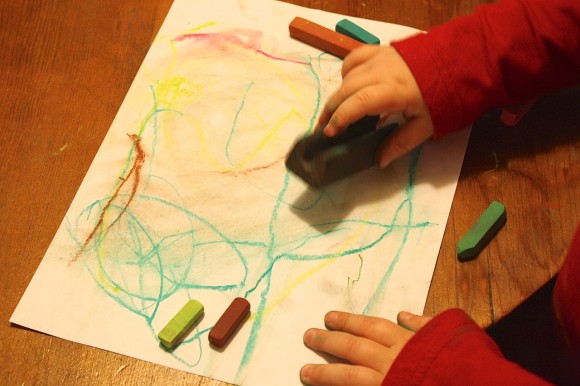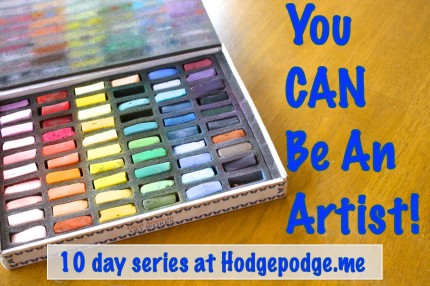Pastel chalks are an easy and almost instantly rewarding way to introduce a student to creativity. And there is a simple answer – just practice.

Using the chalks are often referred to as “painting” rather than drawing. Chalks are pure paint pigment. Yes, they are messy and stain your fingers when you use them. We’ve shared often here at Hodgepodge those gentle tips to help parents get over the mess. The simple steps for how to add art to your homeschool day. Also, how to start art with little ones.
Just Practice
“Well, I’m just not artistic,” you say. Just practice. Yes, you mama. The more often you get out the art supplies, the better you will feel about it. Just practice often. And this, in turn, will give your children the steady gift of practicing being an artist. See, with a bit of concentration, a brave stroke of green in the middle of a white sheet of paper can turn into a spring meadow with rolling hills. Landscapes are the best way to start your pastel art, as you will see in tomorrow’s post.
Pick up the pastel and draw
I have taken many years of classes in all sorts of art: watercolor, acrylics, pastels and basic drawing. The most discouraging aspect of my learning experience was being told that I had the wrong brand of paint, the wrong colors of pastels and used the wrong type of paper or canvas.
Art CAN be very expensive, but the focus of my teaching is not brand names for the “utensils” or brushes, paints and chalk! Start off any new type of art slowly and use the “student brand” of the supplies before investing in expensive supplies. Get used to the medium first! Find your joy in creating before focusing on the extras…..pick up that bright green pastel and paint a horizon line for your landscape.
Don’t Get Discouraged by the Work of Others
If a child is worried about what someone next to him is painting and how her picture looks more like a spring field of poppies, then he begins to miss pure creativity. Allow your children the freedom of painting by themselves if it is at all possible. Have your children take turns or divide your students up in separate rooms and see how they are forced to rely on their own resources to create.
Most pastel paintings only take about 15 minutes to complete, thus allowing more time to practice again. Start small, with plain copier paper, nothing any bigger. You will find that practicing the same scene will allow you to get better and you will want to add tiny flowers in the field or scrubby trees in the distance. Enjoy!
You will see tomorrow how we – all of the children and adults at Hodgepodge – tried our very first chalk pastel tutorial again. Some three years after we originally shared this first tutorial, we wanted to see how our skills had developed. I hope you will be back tomorrow to see!
Just to paint is great fun. The colours are lovely to look at and delicious to squeeze out. Matching them, however crudely, with what you see is fascinating and absolutely absorbing. ~ Winston S. Churchill
Brought to you by these lovely ladies…
Be sure to click over to see all the wonderful series of Spring Hopscotch posts by iHomeschool Network bloggers – 280 posts in all!
- Don’t miss any of our You CAN Be an Artist series – subscribe to Hodgepodge and get your free, subscriber-only art tutorials!
- Browse our art curriculum offerings at chalkpastel.com
Have you found that just getting out the supplies helps you and your children practice art?





Good advise!